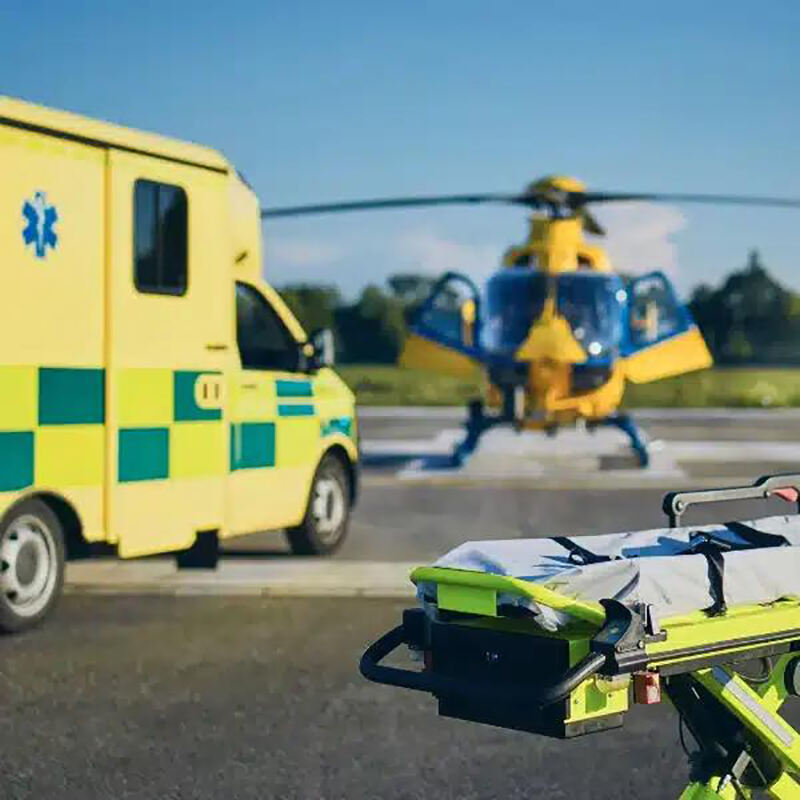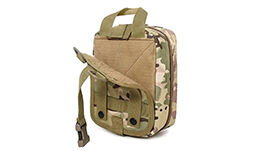Sådan bruger du akutmedicinsk udstyr til traumehjælp: En trin-for-trin guide
Når en nødsituation opstår, er det afgørende at have de rigtige medicinske udstyrstilbehør ved hånden for at kunne give øjeblikkelig hjælp og forhindre yderligere skader. Traumesituationer, såsom ulykker, blødning eller alvorlige skader, kan eskalere hurtigt. Derfor er det afgørende at forstå, hvordan man korrekt bruger nødmedicinsk udstyr. Denne guide gennemgår trin for trin, hvordan du bruger nødmedicinske produkter til behandling af trauma, så du hurtigt og effektivt kan handle korrekt.

Trin 1: Vurder situationen og sikr helsen
Før du bruger noget akut medicinsk udstyr, skal du først sikre, at miljøet er sikkert for både ofret og dig selv. Undersøg mulige farer som trafik, ild eller kemikalier, og fjern eller undgå dem, hvis det er muligt.
Når området er sikkert, skal du vurdere ofrets tilstand. Hvis personen er bevidstløs, skal du tjekke efter tegn på vejrtrækning og blodcirkulation. Hvis personen bløder, kan du være nødt til at handle med det samme for at standse blødningen.
Trin 2: Kontroller blødning med blodafsnøringer og forbindinger
Hvis der er alvorlig blødning, er den vigtigste prioritet at stoppe blodstrømmen. Sådan bruger du blodafsnøringer, forbindinger og andet udstyr effektivt:
·Vridestokblodafsnøring: Ved livstruende blødning fra en arm eller et ben kan en vridestokblodafsnøring placeres over såret for at begrænse blodstrømmen. Spænd blodafsnøringen, indtil blødningen standses. Sørg for at notere tidspunktet, hvor blodafsnøringen er påsættes.
·Forbindinger og gaze: Brug sterile gaze til at dække åbne sår. Tryk let på såret for at stoppe blødningen, og bind derefter en forbinding fast omkring det. Dette vil hjælpe med at minimere blodtab, indtil lægehjælp ankommer.
Trin 3: Stabilisér patienten med en KED-medical enhed
Hvis personen er såret, men ved bevidsthed, kan det være nødvendigt at stabilisere dem, før de flyttes. En KED-medical enhed (Kendrick Extrication Device) er designet til at immobilisere rygmarven og nakken og forhindre yderligere skader under transport.
Sådan bruges en KED-enhed:
·Placer forsigtigt patienten i en siddende position, og sørg for, at hovedet og nakken er understøttet.
·Fastgør enheden omkring overkroppen, og sørg for, at den sidder tæt, men ikke for stramt til at forårsage ubehag eller yderligere skader.
·Når den er sikret, kan patienten transporteres uden risiko for rygsøjleskader.
Trin 4: Kontroller vejrtrækning og giv vejrvejsunderstøttelse
Når blødningen er under kontrol og patienten er stabiliseret, er det vigtigt at overvåge deres vejrtrækning. Hvis personen har svært ved at ånde, skal du bruge KED-enheden for at hjælpe med at holde deres luftveje åbne og deres hoved stabiliseret. Hvis du er trænet i det, skal du give hjertepresser, hvis det er nødvendigt.
Trin 5: Fortsæt med at yde pleje, indtil hjælp ankommer
Hold ofret så rolig som muligt, fortsæt med at overvåge deres tilstand og giv nødvendig førstehjælp, indtil nødpersonale ankommer. Sørg for at give dem vigtig information, såsom ofrets symptomer, eventuelle mediciner, de måtte tage, og de behandlinger, du allerede har givet.
De vigtigste medicinske udstyr til nødreaktion for førstehjælpspersonale
For førstehjælpspersonale er det afgørende at have det rigtige medicinske udstyr til nødreaktion, da det kan være livsvigtigt. Nedenfor er de mest nødvendige forsyninger til at håndtere skader og medicinske nødsituationer:
·Turniqueter: Livreddende til at kontrollere alvorlig blødning fra lemmer. Vindlasspindel-turniquet bruges bredt til dette formål.
·Forbindinger og gaze: Nødvendige til behandling af sår og forebyggelse af infektioner.
·Traume-saks: Bruges til at skære tøj og andre materialer for at få adgang til skader.
·Hjertepustemasker og luftvejsudstyr: Vigtigt for at opretholde en åben luftvej og hjælpe med genoplivning.
·KED-udstyr: Bruges til sikker og effektiv udtrækning af patienter, mens nakke og ryggsøjle stabiliseres.
Ved at have en godt udstyret nødposer, kan førstehjælpspersonale yde hurtig og effektiv pleje i enhver situation.
Sådan anvendes grundlæggende førstehjælp ved brug af akutmedicinsk udstyr
Grundlæggende førstehjælp er grundlaget for effektiv traumepleje. Sådan anvendes den ved brug af akutmedicinsk udstyr:
1.Rens sår: Brug desinficerende tørrevisker eller opløsninger til rengøring af snit eller skrab.
2.Påsæt forbindinger: Brug sterile forbindinger til at dække sår, og bind dem sikkert fast for at forhindre forurening.
3. Stop blødning: Ved alvorlig blødning skal en blødningssnor eller direkte pres med gaze anvendes for at standse blodstrømmen.
4. Immobilisér patienten: Brug en KED-enhed til rygmarvsskader eller understøt det skadede lem med en splint.
Grundlæggende førstehjælpsforanstaltninger kan forhindre, at tilstanden forværres, mens man venter på professionel lægehjælp.
Akut medicinsk udstyr til hjemmepleje: Hvad du har brug for til øjeblikkelig behandling
Hvis du har et nødsæt af akut medicinsk udstyr derhjemme, er du forberedt på uventede situationer. Væsentlige ting, der skal inkluderes i dit hjemmeholdnings-nødsæt:
·Forbindinger og gaze til behandling af sår
·Smertestillende og antiinflammatoriske lægemidler
·Blødningssnore til kontrol af alvorlig blødning
·Behandling af forbrændinger (ved mindre forbrændinger)
·Termometre til at måle feber
·KED-enheder til at sikre at immobilisere en skadet person
Ved at have disse forsyninger tilgængelige kan du håndtere sundhedsmæssige nødsituationer derhjemme, forhindre yderligere skader og sikre rettidig pleje.
Hvornår skal man bruge blodafsnøringsremme, forbindinger og andre akutmedicinske forsyninger
At vide, hvornår og hvordan man bruger akutmedicinske forsyninger, er afgørende. Her er en hurtig guide:
·Blodafsnøringsremme: Brug kun en skrueblodafsnøringsrem, når der er alvorlig arteriel blødning, som ikke kan stoppes med direkte tryk. Dette inkluderer dybe snit i arme eller ben.
·Forbindinger og gaze: Disse er afgørende for mindre sår, forbrændinger eller skrammer. Brug dem til at dække såret og beskytte det mod infektion.
·Hjertepåske- og luftvejsenheder: Hvis patienten ikke ånder, skal du bruge en hjertepåskemaske eller luftvejshjælpenhed til at yde livreddende støtte.
Hver forsyning har en specifik funktion, så at forstå, hvornår de skal bruges, kan forbedre patientresultater i nødsituationer.
Hvorfor vælge Medresq til dine akutmedicinske forsyninger?
Medresq er en ledende leverandør af nødmedicinsk udstyr med base i Kina, som specialiserer sig i OEM/ODM-produktion. Vi tilbyder et bredt udvalg af højkvalitetsprodukter til personlig, kommerciel og offentlig brug, herunder KED medicinsk udstyr, førstehjælpskasser, blodafsnørende bånd og meget mere.
Vi er dedikeret til at levere holdbare, pålidelige og overkommelige nødmedicinske produkter, der lever op til internationale standarder. Vores produkter er designet til at sikre, at du altid er forberedt på enhver nødsituation, uanset om det er derhjemme, i marken eller i katastrofeområder.
Som en pålidelig leverandør af førstehjælpskasser tilbyder Medresq skræddersyede løsninger til partier, der gør det muligt at udstyre dine teams eller kunder med det bedste medicinske udstyr, der er tilgængeligt. Kontakt os i dag, og hør hvordan vi kan støtte dine behov for nødmedicinsk udstyr!
Seneste nyt
-
Fremgang i medicinske strukturer: Forbedring af nødtilsidesættelse og patientomsorg
2025-06-13
-
Den afgørende rolle spillet af bærere i akut medicinsk pleje
2025-03-07
-
UDVIELSEL OG UDSIGT FOR FELTS INDIVIDUELLE FØRSTE HJÆLPSPAKKE
2025-02-20
-
Forbedring af nødtilrettelæggelse: Rollen af IFAK'er i traumaomsorg
2025-02-20
-
Windlass Rod Tourniquet: Et Essentielt Komponent I Nødmedicinsk Forsvar
2025-02-13
-
Windlass Rod Tourniquet: Et livredningsapparat i akutmedicinsk beredskab
2025-02-13
-
Dekompressionsnål: Essentielt Design, Brug og Fremtidige Retninger i Traumacare
2024-11-29
 EN
EN
 FR
FR
 DE
DE
 IT
IT
 JA
JA
 KO
KO
 RU
RU
 ES
ES
 AR
AR
 BG
BG
 HR
HR
 DA
DA
 NL
NL
 FI
FI
 EL
EL
 NO
NO
 PL
PL
 PT
PT
 RO
RO
 SV
SV
 TL
TL
 ID
ID
 SR
SR
 UK
UK
 VI
VI
 SQ
SQ
 TH
TH
 TR
TR
 AF
AF
 MS
MS
 CY
CY
 IS
IS
 HY
HY
 AZ
AZ
 KA
KA
 MN
MN
 MY
MY
 KK
KK
 UZ
UZ
 CS
CS



